Birdfinding.info ⇒ The Bahaman form of Great Lizard-Cuckoo is uncommon in brushy woodlands on Andros and Eleuthera. Consistent sites on North Andros includes Uncle Charlie’s Blue Hole (south of Nicholls Town), Stafford Creek, Maiden Hair Coppice, and Blue Holes National Park. On Eleuthera, it can often be found at Leon Levy Native Plant Preserve and along the side roads around Tarpum Head.
“Bahama Lizard-Cuckoo”
Coccyzus merlini bahamensis
Endemic to Andros and Eleuthera in the central Bahamas. Formerly resident on New Providence as well, but it has apparently been extirpated there, with very few records since the 1990s—presumably the most recent reports were of vagrants.
Identification
A large, lanky, long-tailed, mostly grayish cuckoo, with striking scarlet orbital skin, pale ash-colored throat and breast, cinnamon-buffy belly and vent, and rufous patches on the inner portions of the primaries (most visible in flight).

“Bahama Lizard-Cuckoo,” C. m. bahamensis. (Owens Town, North Andros, Bahamas; March 11, 2018.) © Duncan Mullis
The undertail has a black-and-white pattern that resembles that of several other Coccyzus cuckoos.

“Bahama Lizard-Cuckoo,” C. m. bahamensis. (Owens Town, North Andros, Bahamas; April 7, 2018.) © Craig Watson
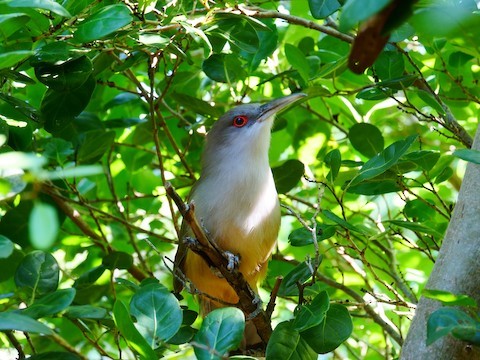
“Bahama Lizard-Cuckoo,” C. m. bahamensis, showing white throat and cinnamon-buff belly. (Leon Levy Native Plant Reserve, Eleuthera, Bahamas; November 23, 2017.) © Elijah Sands

“Bahama Lizard-Cuckoo,” C. m. bahamensis. (Maiden Hair Coppice, Andros, Bahamas; March 26, 2017.) © Robert Norton

“Bahama Lizard-Cuckoo,” C. m. bahamensis, facial close-up showing red orbital skin. (Maiden Hair Coppice, Andros, Bahamas; March 26, 2017.) © Robert Norton
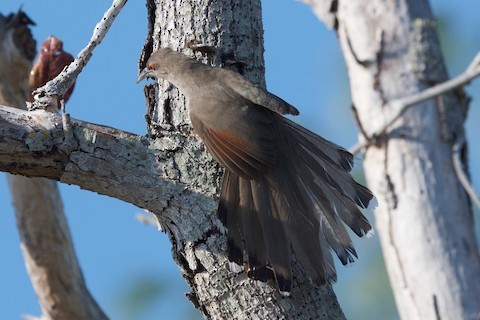
“Bahama Lizard-Cuckoo,” C. m. bahamensis, showing limited rufous patch in primaries and black tips on upperside of central tail feathers. (South Andros, Bahamas; February 9, 2017.) © David Jones

“Bahama Lizard-Cuckoo,” C. m. bahamensis, showing more extensive rufous wing-patches. (Owens Town, North Andros, Bahamas; March 11, 2018.) © Duncan Mullis
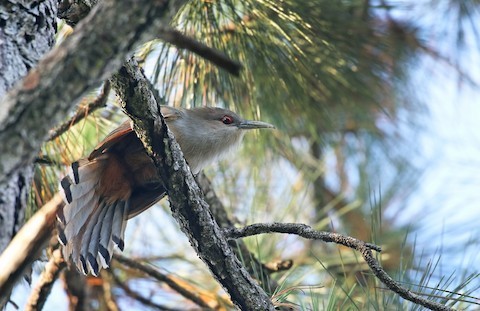
“Bahama Lizard-Cuckoo,” C. m. bahamensis. (Maiden Hair Coppice, North Andros, Bahamas; May 22, 2016.) © Andrew Spencer
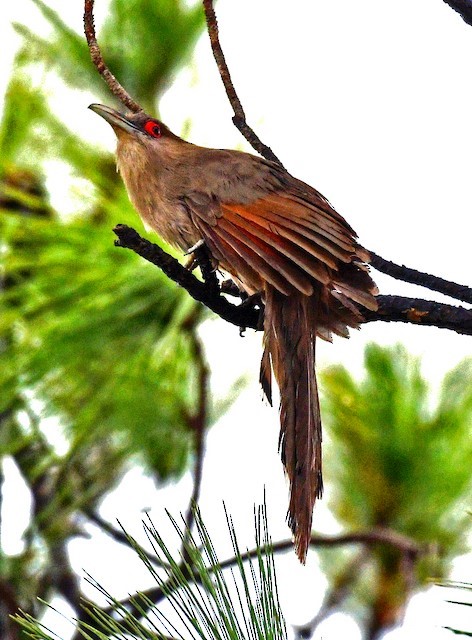
“Bahama Lizard-Cuckoo,” C. m. bahamensis, with apparently warm-brown plumage overall and showing rufous patch in primaries. (Owens Town, North Andros, Bahamas; March 11, 2018.) © Duncan Mullis

“Bahama Lizard-Cuckoo,” C. m. bahamensis. (Mingo Road, Eleuthera, Bahamas; March 16, 2018.) © Stuart White

“Bahama Lizard-Cuckoo,” C. m. bahamensis. (Andros Town, North Andros, Bahamas; January 23, 2015.) © Kas Dumrose
Immatures closely resemble adults but their orbital skin is more dull yellow or orange than red.

“Bahama Lizard-Cuckoo,” C. m. bahamensis, immature—note yellow orbital skin. (Uncle Charlie’s Blue Hole, North Andros, Bahamas; October 27, 2018.) © Keith M. Kemp
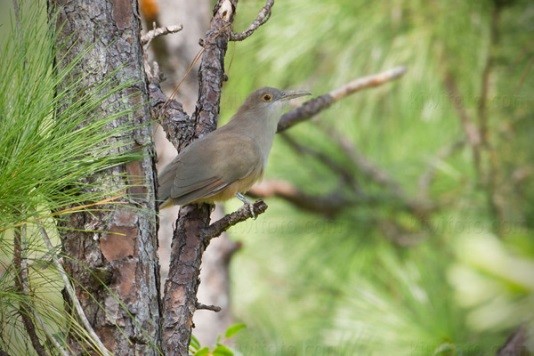
“Bahama Lizard-Cuckoo,” C. m. bahamensis, immature with mostly grayish plumage. (North Andros, Bahamas; September 26, 2011.) © Christopher Taylor

“Bahama Lizard-Cuckoo,” C. m. bahamensis, immature with incomplete tail. (South Andros, Bahamas; February 9, 2017.) © David Jones
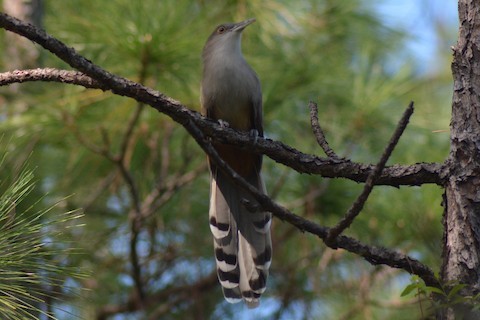
“Bahama Lizard-Cuckoo,” C. m. bahamensis, immature with complete tail. (Uncle Charlie’s Blue Hole, North Andros, Bahamas; October 27, 2018.) © Keith M. Kemp
Voice. The characteristic call of this and the “Cuban Lizard-Cuckoo” is a harsh, guttural staccato rattle that lasts for several seconds, usually at a machine-gun rate during most of the call, but it is somewhat variable: Also various clucks, mutters, and brief rattles: Like the “Cuban” form, “Bahama Lizard-Cuckoo” also has a distinctive two-syllable contact call that consists of a cluck and a moan, Tk!-AAAWW.
Notes
Monotypic form of Great Lizard-Cuckoo that has been regarded as a separate species.
Frontiers of Taxonomy: Are We Splitting the Great Lizard-Cuckoo?
The Handbook of the Birds of the World Alive regards the Cuban and Bahaman forms of Great Lizard-Cuckoo as two species, separating bahamensis, the “Bahama Lizard-Cuckoo,” from the other three recognized subspecies (merlini, santamariae, and decolor), the “Cuban Lizard-Cuckoo,” based on three cited differences in plumage. The proposed split may eventually gain widespread acceptance, but that will likely require further research and analysis, particularly in light of the considerable plumage variation within the three “Cuban Lizard-Cuckoo” subspecies, and the absence of clear vocal distinctions between the “Bahama” and “Cuban” forms.
In general, bahamensis differs visibly from most “Cubans” in being much grayer overall, lacking the “Cuban’s” typically warm-brown upperparts and rusty tones. However, the two subspecies that occupy adjacent Cuban islands—santamariae (Jardines del Rey Archipelago) and decolor (Isle of Youth)—also average much grayer than the mainland Cuban subspecies, merlini. Facially, the most evident difference seems to be between the widespread merlini and the three more localized subspecies, which suggests that “Bahama” has not diverged fundamentally.
The Handbook states that in comparison to “Cuban,” bahamensis differs in having: (1) less extensive rufous in the primaries; (2) a black tip on the uppertail (apparently referring to the upperside of the two central retrices); and (3) purer gray on the breast and paler rufous on the lower underparts. The authors prioritize the rufous wing-patch as more significant than the other two distinctions.
Based on a review of published photographs, it is not clear that the underparts coloration differs at all between the two forms, as bahamensis seems to fall within the “Cuban” subspecies’ wide spectrum of variation. The two remaining plumage differences may be more consistent distinguishing features, but their taxonomic significance is not self-evident. Details of tail and wing coloration appear to vary widely across the Great Lizard-Cuckoo as a whole, and this intrinsic variation makes it difficult to draw definitive lines.
Several recordings of bahamensis and merlini vocalizations are available in the online Macauley Library. Both subspecies give various types of vocalizations, varying in pitch, phrasing, rate, and duration. Upon review of these recordings and those posted on xeno-canto.org, it seems apparent that both subspecies have similar repertoires, consisting of: extended staccato rattling, briefer rattles, isolated clucks, mutters, and a distinctly phrased two-syllable tk!-AAAWW.
References
del Hoyo, J., N. Collar, and G.M. Kirwan. 2019. Bahama Lizard-cuckoo (Coccyzus bahamensis). In Handbook of the Birds of the World Alive (J. del Hoyo, A. Elliott, J. Sargatal, D.A. Christie, and E. de Juana, eds.). Lynx Edicions, Barcelona. https://www.hbw.com/node/467234. (Accessed September 25, 2019.)
eBird. 2019. eBird: An online database of bird distribution and abundance. Cornell Lab of Ornithology, Ithaca, N.Y. http://www.ebird.org. (Accessed September 25, 2019.)
Erritzøe, J., C.F. Mann, F.P. Brammer, and R.A. Fuller. 2012. Cuckoos of the World. Christopher Helm, London.
Garrido, O.H, and A. Kirkconnell. 2000. Field Guide to the Birds of Cuba. Cornell University Press, Ithaca, N.Y.
Payne, R., and G.M. Kirwan. 2019. Cuban Lizard-cuckoo (Coccyzus merlini). In Handbook of the Birds of the World Alive (J. del Hoyo, A. Elliott, J. Sargatal, D.A. Christie, and E. de Juana, eds.). Lynx Edicions, Barcelona. https://www.hbw.com/node/54897. (Accessed September 25, 2019.)
Raffaele, H., J. Wiley, O. Garrido, A. Keith, and J. Raffaele. 1998. A Guide to the Birds of the West Indies. Princeton University Press, Princeton, N.J.
